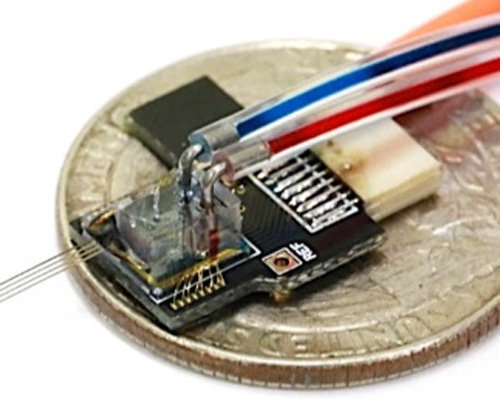Brain microchip developed to help treat brain diseases
Brain microchip developed to help treat brain diseases
Posted August. 23, 2019 09:51,
Updated August. 23, 2019 09:51

A multi-purpose microchip implant for the brain to read people’s minds and treat brain diseases was developed in South Korea. Once the technology becomes more advanced, those with speech impediments can communicate in writing through his or her thoughts and treatments for patients with brain diseases will be found.
A research team of the Korea Institute of Science and Technology (KIST) led by senior researcher Cho Il-joo announced on Thursday that the team successfully developed a brain microchip that reads brain signals and stimulates neurons at the same time. The technology to read people’s thoughts by analyzing brain signals through electrodes implanted in the brain or the technology to send stimulations to the brain to treat brain diseases are already available, but the technology to do both hadn’t existed until the South Korean team’s efforts came to fruition.
The brain chip developed by the KIST team has four 40-micrometer-thick probes, which are thinner than a strand of hair. Each probe has eight electrodes that can both read the brain’s electric signals and send electric simulations. The probes illuminate and release drug, like needles. Their thickness is only one-fifth of the probe of the previously-developed brain chip to minimize the damage to brain tissue during implantation.
The South Korean research team accurately measured the brain signals of mice for each neuron by implanting the newly-develop chip into the subjects’ hippocampi in the brain, which is responsible for memory. The team successfully controlled the connectivity among neurons by stimulating the brain cells in the hippocampi using light and drug.
“Brain diseases appear when normal brain circuits become disconnected or the ones that are supposed to be disconnected become connected to each other,” said senior researcher Cho. “The chip we developed can analyze the brain conditions and provide stimulations to strengthen the connection between disconnected brain circuits while sending weakening stimulations to the abnormally connected ones.” The research is expected to be used for the interface system among the human brain and the computer, and devices to treat brain diseases.
shinjsh@donga.com
Headline News
- N. Korea launches cyberattacks on S. Korea's defense companies
- Major university hospital professors consider a day off each week
- Italy suffers from fiscal deficits from ‘Super Bonus’ scheme
- Inter Milan secures 20th Serie A title, surpassing AC Milan
- Ruling and opposition prioritize spending amid tax revenue shortfalls







